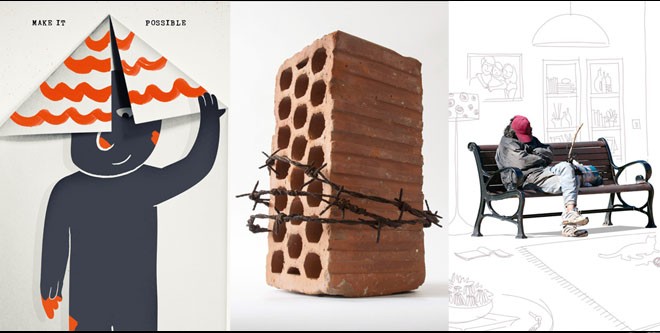

"A poster, a simple, arresting image combined by a powerful piece of text, can be a force for change," says the official description of Poster 4 Tomorrow, founded in 2009 as an independent, non-profit organisation based in Paris, promoting human rights issues through graphic design.
For 2013 the theme of the poster competition was A Home for Everyone, and no less than 3461 posters were submitted, of which 400 posters were short listed by an online jury of 100 men and women representing 50 different nationalities. Afterwards, an international jury of 13 leading graphic designers met in Paris to select the final 100 posters.
It is to the credit of a Karachi-based artist, Khuda Bux Abro, that each year the Poster 4 Tomorrow exhibit is organised at the Arts Council for a few days. Furthermore, his poster was the only entry from Pakistan that found a place in the 300 posters that were initially short listed.
A Home for Everyone – the 100 posters’ exhibition was held in collaboration with the Human Rights Commission of Pakistan and was inaugurated on January 24 by renowned architect, planner and activist, Arif Hasan, who addressed the visitors on the occasion. As Chairperson, Orangi Pilot Project’s Research & Training Institute, and Chairperson of the Urban Resource Centre, Karachi, Arif Hasan has vast experience of dealing with national and international urban planning and development issues.
Hasan said that the housing issue is universal. Where there is more poverty the problem is more acute. He spoke at length about the repercussions of evictions and relocation and pointed the problems with formal public sector development schemes in Pakistan: too few; too expensive, with complicated procedures and infrastructure and credit issues. Nevertheless, Hasan and his colleagues have indicated through their research that "there are alternatives that combine the advantages of incremental, community-friendly development with those of good design and long-term planning. If sufficient land can be made available in the right locations, such approaches could help turn urbanisation into one of Asia’s biggest opportunities."
I was struck by the variety of ideas and executions of the 100 best posters. However, there were also some that displayed similar concepts. For example, a poster titled I Live Here, created by El Hazmiri Cawtar from Morocco has a photograph of a homeless person sitting on a corrugated cardboard sheet with a rolled up blanket and pillows, but all around him are chalk drawings of the basics: a water tap, a light bulb, a television set and a radiator for warmth. A plant kept on top of the heater caught my eye as it added a charming reminder that a home could be considered incomplete without it.
An Untitled poster by Luis Veiga of Portugal also has a photograph, of a man sitting on a park bench, perhaps asleep, and a picture of a living room is drawn in the background. Taiwan’s Hsueh Yi Ji’s design captioned Homeless, is also in the same league, showing a park bench photo with a simple line drawing of a house over it. Thai artist Bunsopis Prim’s Let’s Live for Today shows a homeless person sitting on a footpath with an architect’s plan of a house drawn on the concrete; marking the entrance, the drawing room, bedroom, bathroom and kitchen. The irony of having sweet dreams in the face of brutal realities is not lost on the viewer.
We may all be quite familiar with the phrase "Home Sweet Home" written typically with cross-stitch embroidery, adorning a home-maker’s living room. Javier Perez from Ecuador has used the same concept with a small twist to his poster imagery with Home Sweet Home for All written in cross-stitch, whereas another "Home Sweet Home" appears as a crocheted doily designed by Nathalie Cornelis of Belgium.
The above are just a few examples of some great creative minds thinking on similar lines; but as mentioned before, over all the great diversity of thought and rendering in the 100 short listed posters is arresting.
Several other posters are extremely poignant. Canadian artist Rousseau Mathieu’s Where are you sleeping tonight? is outstanding, with an orange bench screaming out against a jungle of gray houses. Another unforgettable one is Tomaso Marcolla’s Unable (Italy), depicting helplessness through a single red building block with a barbed wire going around it. From Brazil an entry by Garla Ricardo titled Cemetery also has a minimal but effective imagery -- a tombstone fashioned from a used corrugated cardboard piece with the words "Homeless" written across it. A question mark for the year of birth and the year 2013 as the year of death completes the picture.